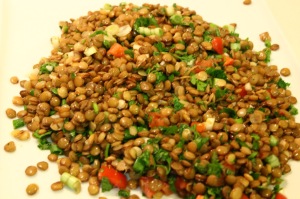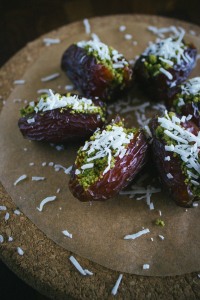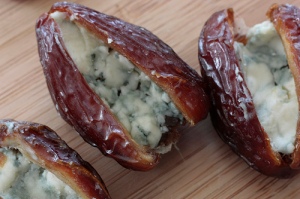Serves 4
I ate a lovely, warming, filling brunch of huevos rancheros (or mexican ranch-style beans) in a Chiquitos restaurant near the O2 in London recently. This was in preparation for my ascent to the top of the O2 – that’s right, you can climb it to a viewing
platform mountaineering style and get fab views of London City and the river on a clear day (we got lucky with the weather)! Awesome fun, and the breakfast set me up a treat!
I digress! This is my own home-cooked version that I have only just got round to making 2 weeks later because I’ve not had time to soak and boil my beans!
This is a well-balanced brekkie plate with plenty of fresh anti-oxidant-rich veggies for fibre and vitamins, black beans for muscle-building protein and a bit of a kick to wake you up for the day. Who said hot breakfasts had to be bland, unhealthy, stodgy and full of saturated fat?! Black beans are high in fibre (aids weight loss because it fills you up, and boosts the health of the gut), low in fat, and contain a decent amount of iron (important for building red blood cells and preventing anaemia), folate (important for red blood cells and transport of oxygen to the muscles and prevents spina bifida in unborn children), magnesium and potassium.
If you have to get the dried black beans that need soaking I would recommend preparing more than you need as you can always freeze them once cooked for easy use at a later date.
INGREDIENTS:
BLACK BEANS
400g black beans, cooked (use canned pinto beans, drained, if you cannot find black beans)
200ml vegetable or chicken broth, made with ½ a 10g stock cube
1 tbsp. vegetable oil
2 cloves garlic, minced
1 tbsp. jalapeno pepper, finely chopped
THE SALSA

Black (turtle) beans. High in fibre and carbohydrate but low in fat. Contain iron, folate, magnesium and potassium.
1 large red onion, chopped (185g)
1 large red pepper, chopped (145g)
1 clove garlic, minced (4g)
1 can chopped tomatoes or 4 fresh tomatoes, finely chopped (400g)
1 can of sweetcorn kernels (160g)
1 tbsp. jalapeno pepper, finely chopped
2 tbsp. fresh coriander or cilantro, chopped
2 tbsp. fresh lime juice
salt, to taste
4 tortillas (40g each)
4 eggs
INSTRUCTIONS:
- Soak the black beans in cold water overnight (24 hours). Place in a large saucepan, cover with double the amount of water, and bring to the boil. Reduce heat to medium, cover and leave to cook for at least 2 hours or until the beans are softened but not breaking apart. Add more water if it starts to dry out. Drain and leave to cool.
- To make the salsa, stir the tomatoes, red onions, red pepper, sweetcorn, coriander or cilantro, lime juice, jalapeno pepper, minced garlic, and salt to taste, together in a bowl until well blended. Cover, and refrigerate until needed (at least 1 hour).
- Place the oil in a frying pan over a medium heat. Stir in the garlic, and cook 1 minute until light brown. Mix in the black beans or drained pinto beans if using these instead, the broth and 1 tbsp. jalapeno pepper. Simmer until beans are heated through (about 5 minutes). Turn off heat, and keep warm.
- Preheat oven to 190°C / 375°F / gas mark 5. Place tortillas on a baking sheet with greaseproof paper underneath. Cook for 1-2 minutes, until warmed through and softened. Alternatively, heat in microwave on full power for 30 – 45 seconds.
- Poach or scramble the eggs and cook to desired firmness.
- To assemble huevos rancheros, place a tortilla on each plate. Top each tortilla with black bean mixture, a layer of salsa, and an egg (or ¼ of the scrambled eggs). Serve immediately.
SUGGESTIONS
– Add 1 inch of chorizo, chopped into small squares = additional 68 kcal / 285 kJ
For a main meal, per portion:
– Add 20g of grated cheddar cheese = additional 83kcal / 347 kJ
and/or
– 50g of shredded roast chicken (instead of the eggs) = 89 kcal / 372 kJ
– 50g of shredded roast pork (instead of the eggs) = 91 kcal / 381 kJ
– 50g of shredded roast beef (instead of the eggs) = additional 110 kcal / 460 kJ
NUTRITIONAL INFORMATION
per whole recipe
Energy 1495 kcal / 6255 kJ
Carbohydrate 229.7g
Fat 38.2g
Protein 64.2g
Total sugar 53.3g
Saturates 12.0g
Fibre 48.4g
Salt 8.4g (check canned beans for added salt)
per serving (if serving 4)
Energy 374kcal / 1565 kJ
Carbohydrate 57.4g
Fat 9.6g
Protein 16.1g
Total sugar 13.3g
Saturates 3.0g
Fibre 12.1g
Salt 2.1g (check canned beans for added salt)
The humble date often makes an appearance at Christmas – about the only time of year that you seem to be able to buy the gorgeous, sticky, squidgy Medjool style date, as opposed to the small, shrivelled, dry ones you are forced to be content with the rest of the year round!
Dates are a fruit in their own right, not the dried version of something else. Although higher in calories than most fresh fruits, they do also contain a fantastic range of nutritional benefits and so are definitely a good alternative to chocolate if you are craving something sweet this Christmas.
NUTRITIONAL BENEFITS
Fibre: dates are high in fibre which helps our digestive systems to function smoothly (pardon the pun!), prevents constipation, promotes gut health and also can help to reduce cholesterol levels in the blood.
B Vitamins: Dates contain a good amount of niacin, riboflavin and folate. These are all part of the B Vitamin family which help to support a range of bodily functions.
Riboflavin (B2): supports the health of the nervous system and can help promote skin and eye health as well as helping our bodies to release the energy from carbohydrate.
Niacin (B3): helps to promote the health of the digestive and nervous systems
Folate: helps to support Vitamin B12 to promote the production and health of red blood cells, therefore supporting the transport of oxygen to the muscles and preventing fatigue. It is also a vital vitamin during pregnancy as it prevents conditions such as spina bifida from developing in newborns.
Iron: Dates contain a decent amount of iron; any foods containing iron are good to eat as this is one of the minerals that we can so easily become deficient in, especially if we do not eat meat. Iron helps to build red blood cells which carry oxygen to muscles as a source of energy. If we are deficient in iron we can develop anaemia, a symptom of which is extreme fatigue and lack of energy.
Calcium: Dates contain a small amount of calcium, which promotes bone health, growth and development and is involved in cardiac function, so can help to keep the heart strong and healthy.
HOW TO STUFF A DATE!
Easy!
1. Slice the date down one side, being careful not to cut all the way through as you want to keep it whole.
2. Carefully remove the stone. A good treat here, as there is often some date flesh still on the stone – it’s chef’s perogative to suck the stones! Just as satisfying as licking the spoon!
3. Take one whole almond, pistachio, walnut half, cashew or a nut of your choosing and place this where the stone used to be. Alternatively, stuff the cavity with chopped nuts.
4. Roll the stuffed date in grated coconut or sprinkle some on top for a delicious treat and a beautiful festive, snowy look
5. Alternative stuffings are:
* cream cheese (low fat, if you want to keep it healthy)
* blue cheese
* thick, lowfat greek style yogurt and honey
* bacon, wrapped around the date like pigs-in-blankets (obviously the bacon needs to be cooked first)
NUTRITIONAL INFORMATION
per one date, stuffed with an almond and rolled in coconut (per one date stuffed with blue cheese)
Energy 93kcal / 389kJ (86kcal / 360 kJ)
Carbohydrate 8.1g (7.8g)
Fat 2.5g (1.5g)
Protein 1.0g (1.4g)
Sugars 8.0g (7.8g)
Saturates 1.2g (1.0g)
Fibre 1.0g (0.5g)
Salt Trace (Trace)
Serves 4

Delicious, crunchy and packed with fibre, protein, iron and folate.
With the weather starting to turn warmer, even if only sporadically and for 2-3 days out of every month in the UK, this weekend was so beautiful that it just wasn’t soupy weather! I decided to make a nice salad instead – my staple lunch during the summer months being a plate of different mixed salads like those you might see in a health food/wholefood cafe.
You can use green or brown lentils in this salad and these types are especially good in salads and casseroles because they hold their shape well after cooking (yellow and red lentils or split peas have a tendency to go mushy making them better in soups and dahls). They also lend it a really nice crunchy texture and nutty flavour which goes beautifully with the crunchy fresh veggies and parsley.
I would eat this salad as a meal on its own, maybe with a tbsp. of low fat hummus, lettuce, cucumber, cherry tomatoes and ½ pitta bread. I have eaten it on the side of a main meal such as baked fish or chicken, lasagne, moussaka or as part of a salad plate with other salads in which case I would have 1-2 tbsps. of salad rather than a large plateful. I have included the nutritional information for the whole recipe here so that you can make your own calculations if you decide to portion the salad differently; e.g. if you were to eat it on the side of a main meal rather than as a salad meal in its own right.Lentils are high in fibre, protein and a multitude of vitamins and minerals including iron, folate and calcium. They are low in fat and, because of the high fibre and protein contents, they can really help your stomach to feel fuller for longer making them a great addition to a lunch time meal as this can curb those afternoon snack cravings.
Normally you would find lentils dried and sold in bags ready for cooking although some supermarkets and specialist food stores such as south Asian supermarkets sell them already cooked in cans. I have used dried lentils so I needed to cook them – if you used canned lentils just miss out the first step and be aware that the canning process probably added extra salt to the overall nutritional content as a preservative.
Ingredients
200g dried green lentils or 2 cans cooked, drained green lentils (480g)
1 red pepper, chopped
1 green pepper, chopped
1 red onion, chopped (or equivalent amount of chopped spring onions)
1 garlic clove, finely diced
2 tbsp. fresh parsley, chopped
–
1 tbsp. olive oil
1.5 tbsp. white wine or cider vinegar
1 tsp. runny honey
2 tsp. lemon juice
Some grated lemon zest (optional)
Ground black pepper
Instructions
1. Place the lentils in a saucepan with 3 times the amount of cold water as lentils. Bring the water to a boil then reduce the heat and boil gently for 35 – 45 minutes, or until the lentils are soft but retain a bit of crunch. Remove from heat, drain off the water and allow to cool for later.
2. Finely chop the vegetables and parsley – these will stay raw so small is better unless you particularly like to eat large chunks of raw onion! Mix these together in a big bowl.
3. In a small bowl, mix together the oil, vinegar, honey, lemon juice, lemon zest (if using) and black pepper. Make sure the honey is well blended with the rest of the ingredients.
4. Pour the dressing over the vegetables and add the cooked lentils once they have cooled sufficiently.
5. Stir everything together and put the salad in the fridge for an hour or two to allow the dressing to infuse the vegetables with flavour.
NUTRITIONAL INFORMATION
per whole recipe
Energy 870 kcal / 3645 kJ
Carbohydrate 132.4g
Fat 15.4g
Protein 54.4g
Total sugar 31.7g
Saturates 3.4g
Fibre 26.0g
Salt 0.1g (check canned lentils for added salt)
NUTRITIONAL INFORMATION
per serving (if serving 4)
Energy 220 kcal / 911 kJ
Carbohydrate 33.1g
Fat 3.9g
Protein 13.6g
Total sugar 7.9g
Saturates 0.9g
Fibre 6.5g
Salt Trace (check canned lentils for added salt)



